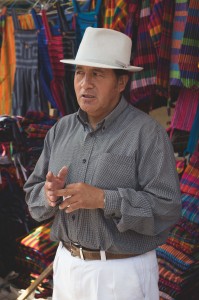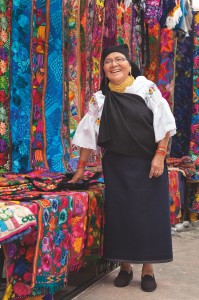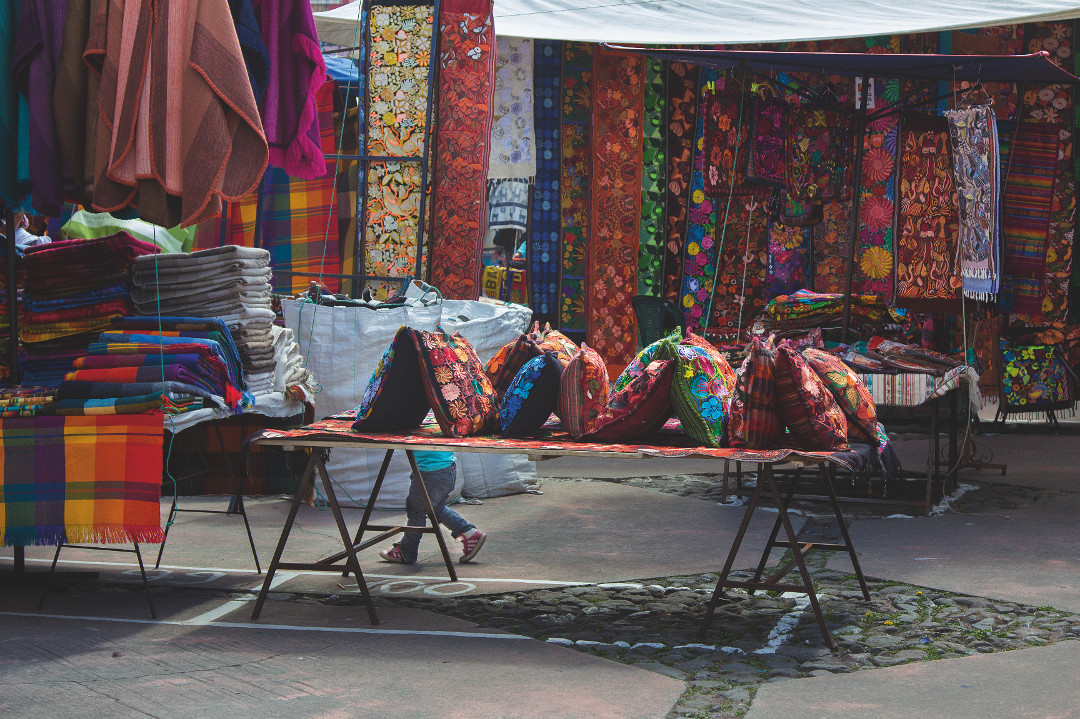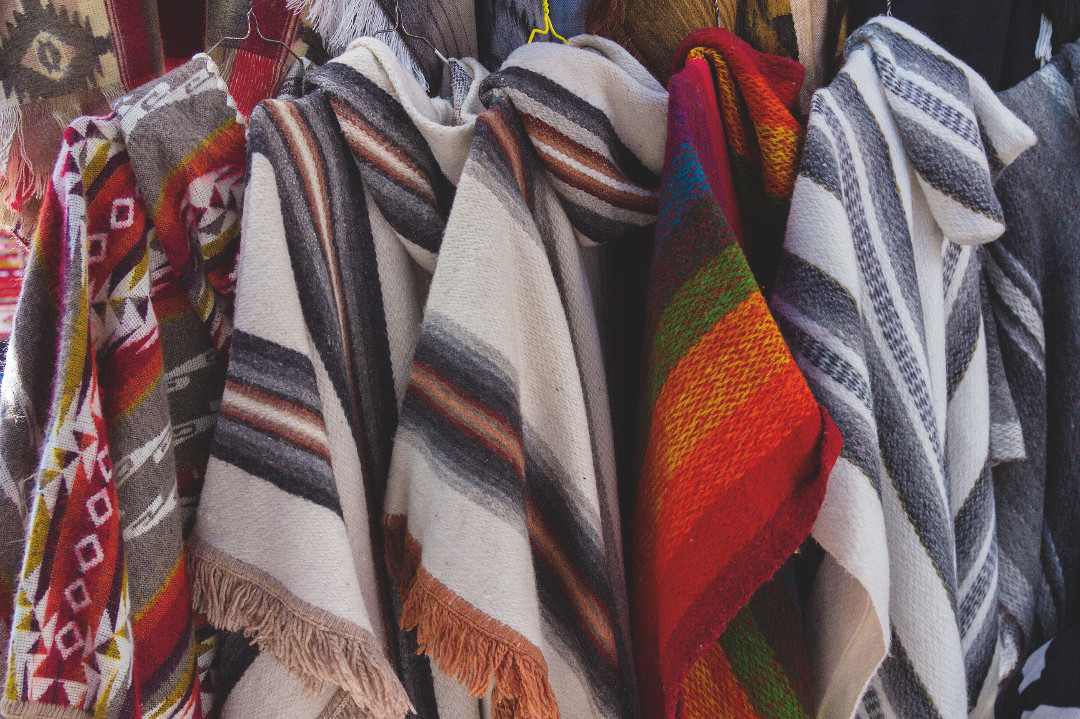A CULTURE OF HANDICRAFTS
 Plaza of the Ponchos is one of Ecuador’s best known handicrafts markets. The visitor’s experience can go way beyond just buying stuff. It can really transcend into the marvelous experience of meeting artisans from different Indian communities and earning an insight into their culture.
Plaza of the Ponchos is one of Ecuador’s best known handicrafts markets. The visitor’s experience can go way beyond just buying stuff. It can really transcend into the marvelous experience of meeting artisans from different Indian communities and earning an insight into their culture.
About 80% of the city’s families work on handicrafts
San Luis of Otavalo is about two hours north of Quito. Its population is 50% rural and there we find the various Indian communities, among them, San Juan, Peguche, Punyaro, Pucará, Rey Loma. Héctor Tipán, born in Otavalo and a member of the local Board of Economic and Tourist Development, explains that about 80% of the city’s families work on handicrafts. Consequently, this activity is not only the main tourist attraction but also the key source of income.
Most tourists who arrive in Quito usually have scheduled a half day visit to Otavalo. Nevertheless, no one should miss this trip! Otavalo offers an experience distinctly different from normal big city tours.
Although the town has its own charm, a visit to the Plaza de Ponchos is mandatory. Every day the Plaza de Ponchos fills the central square, known as Plaza Centenario. On Wednesday the market expands to include one side street of the Plaza. Saturday is the market’s highpoint. All the nearby streets are closed so the market extends over five blocks with a spectacular display of handicrafts. Magical colors, striking textures, indigenous costume jewelry and plenty other features draw large crowds of local and foreign visitors.
Location:
A 110 km de Quito
3.500 Merchants:
On Saturday
450.000 Visitors
About a year
The artisans ́daily presence at the Plaza de Ponchos reflects their cultural heritage. Generation after generation, Indian families have gathered there, making this Plaza a center for community integration. Berta is an artisan who has gone every day to the market since she was nine years old. Her parents took her with them and, over time and with practice, Berta inherited her family’s artisan culture. Her brothers are also artisans. While she is into textile crafts, they specialize in costume jewelry, bracelets and collars made of ivory palm. Berta believes the key to making sales is to have “a little bit of everything”. However, since no one can produce an entire range of handicrafts, the artisans exchange their goods. So, eventually, most families sell basically the same variety of products to their customers.
VISITING HOURS
Every day:
7am – 5pm
Wednesday:
The market expands to include one side street of the Plaza
Saturday:
Is the market’s highpoint
Mariana is another artisan who has had a stand in the Plaza de Ponchos for the past 15 years. She buys all her wares because she has no facilities to produce them, yet she is committed to keep her lifelong calling.
According to Tipán, sales have grown to such a scale that some machinery has now been acquired in order to increase production volumes and shorten timeframes so a larger semi-industrial supply can be sold at reasonable prices. Nevertheless, most of the handicrafts on sale are still entirely handmade. However, their price is considerably higher and so the volume sold is smaller.
The Plaza de Ponchos artisans feel grateful towards all tourists. They are fully aware of the tourist’s key role in the handicrafts markets
In one of the colorful market passages we find Luz María, a 65 year old woman who no longer remembers just how many years she has been coming daily to deal with customers from all over the world. An extremely kind person, she stands apart because, unlike most, she only makes wall hangings. These are totally handmade, very colorful and huge, up to 8 feet wide. Her craft is so detailed that, at a glance, Luz María’s skill is evident. The price for each wall hanging is $110 dollars but, immediately, she points out that she’s willing to bargain. For such an authentic quality handicraft, the price is well worth it. Each piece is unique and takes 15 days to produce.
 The beauty, and the price, of all handicrafts rest on their production process. Rosa Castañeda has been making blankets for the past 15 years. Her most popular product is made with alpaca wool blended with lightweight acrylic fiber. The first step is the warp (preparing the yarns) and next is the weaving itself. Carding, the process of cleaning and disentangling fibers, follows. This is done manually with a brush made from a local plant. The fabric is then cut to produce blankets 6 feet wide and 8 feet long. Finally, each blanket is ironed. The entire process takes one week. These blankets have great appeal for tourists who hail from countries with cold seasons.
The beauty, and the price, of all handicrafts rest on their production process. Rosa Castañeda has been making blankets for the past 15 years. Her most popular product is made with alpaca wool blended with lightweight acrylic fiber. The first step is the warp (preparing the yarns) and next is the weaving itself. Carding, the process of cleaning and disentangling fibers, follows. This is done manually with a brush made from a local plant. The fabric is then cut to produce blankets 6 feet wide and 8 feet long. Finally, each blanket is ironed. The entire process takes one week. These blankets have great appeal for tourists who hail from countries with cold seasons.
The Plaza de Ponchos artisans feel grateful towards all tourists. They are fully aware of the tourist’s ́key role in the handicrafts markets. It’s the tourists who have transformed their cultural heritage into a practical trade that provides their daily income. Undoubtedly, a visit to Plaza de Ponchos is highly recommended. Even more so when the tourist can take time from shopping and haggling to walk slowly through the Plaza, appreciate the heritage embodied in the wealth of handicrafts and participate in the cultural exchange offered by the local artisans.


